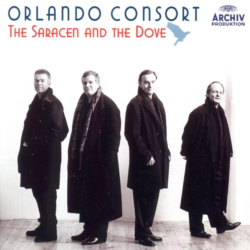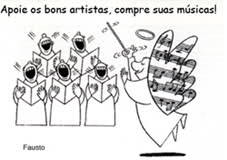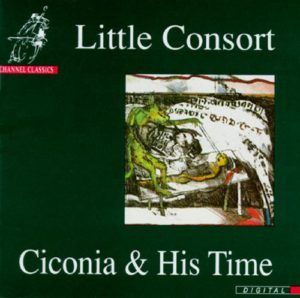 Music from the Courts of Padua and Pavia
Music from the Courts of Padua and Pavia
XV century
Orlando Consort
Ars subtilior (more subtle art) is a musical style characterized by rhythmic and notational complexity, centered on Paris, Avignon in southern France, also in northern Spain at the end of the fourteenth century. The style also is found in the French Cypriot repertory. Often the term is used in contrast with ars nova, which applies to the musical style of the preceding period from about 1310 to about 1370; though some scholars prefer to consider the ars subtilior a subcategory of the earlier style. Primary sources for the ars subtilior are the Chantilly Codex, the Modena Codex (Mod A M 5.24), and the Turin Manuscript (Torino J.II.9).
Musically, the productions of the ars subtilior are highly refined, complex, difficult to sing, and probably were produced, sung and enjoyed by a small audience of specialists and connoisseurs. Hoppin suggests the superlative ars subtilissima, saying, “not until the twentieth century did music again reach the most subtle refinements and rhythmic complexities of the manneristic style.” They are almost exclusively secular songs, and have as their subject matter love, war, chivalry, and stories from classical antiquity. There are even some songs written in praise of public figures (for example Antipope Clement VII). Daniel Albright compares avant-garde and modernist music of the 20th century’s “emphasis on generating music through technical experiment” to the precedent set by the ars subtilior movement’s “autonomous delight in extending the kingdom of sound.” He cites Baude Cordier’s perpetual canon Tout par compas (All by compass am I composed), notated on a circular staff.
One of the centers of activity of the style was Avignon at the end of the Babylonian Captivity of the Papacy and during the Great Schism (1378–1417), the time during which the Western Church had a pope both in Rome and in Avignon. The town on the Rhône had developed into an active cultural center, and produced the most significant surviving body of secular song of the late fourteenth century.
The style spread into northern Spain and as far as Cyprus (which was a French cultural outpost at the time). French, Flemish, Spanish and Italian composers used the style.
Johannes Ciconia (c. 1370 – between 10 June and 13 July 1412) was a composer and music theorist of the late Middle Ages. He was born in Liège, but worked most of his adult life in Italy, particularly in the service of the papal chapel(s) and at Padua cathedral.
Bartolino da Padova (also “Magister Frater Bartolinus de Padua”) (fl. ca. 1365 – ca. 1405) was an Italian composer of the late 14th century. He is a representative of the stylistic period known as the Trecento, sometimes known as the “Italian ars nova”, the transitional period between medieval and Renaissance music in Italy.
Antonello da Caserta, also Anthonello, Antonellus Marot, was an Italian composer of the medieval era, active in the late 14th and early 15th centuries. Essentially nothing is known of Antonello’s life. Earlier in the 20th century, Nino Pirrotta thought Caserta was a Neapolitan composer, but because most of his surviving works are in northern Italian manuscripts, this is disputed. Allusions in his texts suggest that he worked for the Visconti family in Milan around the turn of the 15th century, and archival documents place him in Pavia in 1402. Antonello was a monk, though the order to which he belonged is not known.
Antonio “Zacara” da Teramo (in Latin Antonius Berardi Andree de Teramo, also Zacar, Zaccara, Zacharie, Zachara, and Çacharius; b. probably between 1350 and 1360 – d. between May 19, 1413 and mid-September 1416) was an Italian composer, singer, and papal secretary of the late Trecento and early 15th century. He was one of the most active Italian composers around 1400, and his style bridged the periods of the Trecento, ars subtilior, and beginnings of the musical Renaissance. (Textos da Wikipedia)
The Saracen and the Dove
Johannes Ciconia (Bélgica, 1370-Itália, 1412)
01. Doctorum Principem/Melodia Suavissiama/Vir Mitis, motet
02. Per Quella Strada Lactea for 2 voices
Bartolino da Padova (Itália, 1365-1405)
03. Imperial sedendo fra piú stelle, madrigal for 3 voices (Squarcialupi Codex fol.109v-110)
Johannes Ciconia (Bélgica, 1370-Itália, 1412)
04. O felix templum jublia, motet
Anonymous (Séc. XV)
05. O Maria, virgo davitica / O Maria, maris stella, motet
Johannes Ciconia (Bélgica, 1370-Itália, 1412)
06. O Padua, sidus preclarum, motet
Bartolino da Padova (Itália, 1365-1405)
07. La douce çere d’un fier animal, madrigal for 3 voices (Squarcialupi Codex fol.101v-102)
Johannes Ciconia (Bélgica, 1370-Itália, 1412)
08. Con lagreme bagnandome nel viso, for 2 voices
Johannes Ciconia (Bélgica, 1370-Itália, 1412)
09. Gloria “Spiritus et alme” for 4 voices
10. Una panthera in compagnia di marte, madrigal for 3 voices
Anthonello da Caserta (Itália, 1355-1402)
11. Del glorioso titolo d’esto duce, madrigal for 2 voices
Antonio Zachara da Teramo (Itália, 1355-1416)
12. Un fior gentil m’apparse, song for 3 voices
Johannes Ciconia (Bélgica, 1370-Itália, 1412)
13. Sus une fontayne, for 3 voices (Modena Codex fol.27v-28r)
14. Le ray au soley!, canon
Antonio Zachara da Teramo (Itália, 1355-1416)
15. Sumite, karissimi, capud de Remulo, patres, song for 3 voices (Modena Codex fol.12v-13)
16. Dime Fortuna poy che tu parlasti, ballata for 2 voices (attributed)
17. Gloria “Ad ogni vento”, mass movement for 4 voices
The Saracen and the Dove – 1999
Orlando Consort
BAIXE AQUI – DOWNLOAD HERE
FLAC 335,4 MB
BAIXE AQUI – DOWNLOAD HERE
MP3 320 kbps – 183,6 MB – 1 h 15 min
powered by iTunes 11.1.3
Na falta de um encarte, seguem algumas referências:
• http://en.wikipedia.org/wiki/Ars_subtilior
• http://www.medieval.org/music/ccc/aaaa981022.html
• http://www.allmusic.com/album/the-saracen-and-the-dove-music-from-the-courts-of-padua-and-pavia-mw0001827491
• http://www.amazon.com/The-Saracen-Dove-Courts-around/dp/B00000JLFO
Boa audição.

Avicenna
 Johannes Ciconia (Liège, 1335 ou 1370 – Pádua, entre 10 e 12 de junho de 1412) foi um compositor e teórico musical flamengo da Idade Média tardia que trabalhou durante a maior parte de sua vida adulta na Itália, particularmente na corte papal e na catedral de Pádua. A grande disparidade entre as possíveis datas de seu nascimento deve-se ao fato de que seu pai tinha o mesmo nome, e, assim, a biografia de ambos tem sido confundida. Porém todas as suas obras conhecidas são posteriores a 1390. Este disco é formado por típicas canções da Idade Média, extremamente valorizadas pelo Little Consort. A música de Ciconia mostra um cruzamento de várias influências, algumas do norte da Itália e outras da França. Algumas de suas peças já indicam um caminho para os padrões de melodia típicos da Renascença. Deixou baladas, madrigais, motetos e movimentos de missas. Também escreveu tratados sobre a arte da composição.
Johannes Ciconia (Liège, 1335 ou 1370 – Pádua, entre 10 e 12 de junho de 1412) foi um compositor e teórico musical flamengo da Idade Média tardia que trabalhou durante a maior parte de sua vida adulta na Itália, particularmente na corte papal e na catedral de Pádua. A grande disparidade entre as possíveis datas de seu nascimento deve-se ao fato de que seu pai tinha o mesmo nome, e, assim, a biografia de ambos tem sido confundida. Porém todas as suas obras conhecidas são posteriores a 1390. Este disco é formado por típicas canções da Idade Média, extremamente valorizadas pelo Little Consort. A música de Ciconia mostra um cruzamento de várias influências, algumas do norte da Itália e outras da França. Algumas de suas peças já indicam um caminho para os padrões de melodia típicos da Renascença. Deixou baladas, madrigais, motetos e movimentos de missas. Também escreveu tratados sobre a arte da composição.

